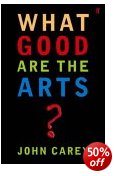a bracing and polemical look at theories of art
The chapter titles of John Carey’s book on art theory make his sceptical position quite clear. ‘What is a work of art?’, ‘Is ‘high’ art superior?’, ‘Do the arts make us better?’, ‘Can art be a religion?’. He is taking a radical perspective on claims that are traditionally made for the appreciation of art. And his answers to those questions (in order) are – Art can be anything people claim it is – No, ‘high’ art is not necessarily superior – No, there is no evidence it makes us better – and Yes, unfortunately, art is sometimes seen as a form of religion. He asks challenging questions and raises points some readers might find quite difficult to take on board.
 For instance, on the issue that the appreciation of art is capable of inducing feelings of transcendent ecstasy, he points out that such states of mind can be perceived as essentially complacent and selfish, since they are customarily associated with a feeling of harmony and oneness with the world. In a world where a huge part of its population is living in starvation and misery, this is hardly a desirable state of being and certainly not one which can claim to be ethically superior.
For instance, on the issue that the appreciation of art is capable of inducing feelings of transcendent ecstasy, he points out that such states of mind can be perceived as essentially complacent and selfish, since they are customarily associated with a feeling of harmony and oneness with the world. In a world where a huge part of its population is living in starvation and misery, this is hardly a desirable state of being and certainly not one which can claim to be ethically superior.
He manages some of his arguments by slightly devious means. For instance in attacking Kant’s absolutist values he claims that aesthetics were ‘invented’ in the eighteenth century – conveniently omitting Aristotle’s Poetics which he clearly knows about, because he mentions them in a later chapter.
It’s a very amusing read, because he takes an ironic and dismissive attitude to the snobs and the vainglorious commentators on art, including some celebrated figures whose bogus ideas he is debunking. Nobody is spared: lots of Big Names are dealt with by almost summary execution – Kant, Hegel, Schopenhauer – all ‘essentialists’ who believed that great works of art had something unreachable and transcendent which lesser works did not. But they couldn’t ever prove it.
His assessment of the American art collector John Paul Getty is typical. Pointing out that Getty’s personal opinions included support for eugenic engineering and capital punishment, he observes:
Viewed as a humanising influence, the Getty art collection was admittedly a failure insofar as it affected its owner … There is little point in acquiring two Rembrandts and a Rubens if your social views remain indistinguishable from those of any saloon-bar fascist.
You’ll have to hold on to your intellectual hat when he gets round to extolling Adolf Hitler’s interest in painting , architecture, and music – but it’s only to argue that Western culture can easily co-exist with barbarity when it is elevated to a form of quasi-religious belief.
He does skip around somewhat between painting, literature, music, and other forms of traditional art – but ultimately nails his colours to the mast in the second half of the book when he defends literature. He does so on the grounds that unlike the other arts it is self-reflective. That is, it can criticise itself, and offer multiple moral perspectives. Indeed, it demands more of participants than the other arts, because it must be interpreted through the act of reading.
He even celebrates its indistinctiveness, which accounts for so many possible interpretations – which then come out and compete with each other for acceptance. All this is illustrated by close readings from novels and poetry straight from the traditional English Literature curriculum.
When it first came out, this book upset a lot of people with an interest in maintaining ‘essentialist’ positions. So he even indulges himself with a postscript in which he replies to all the reviewers who took offence – saving his most withering remarks for the likes of the self-aggrandising ‘religion of art’ supporter Jeanette Winterson.
It’s a very invigorating and entertaining read. And it’s likely to make most people think twice about the claims they make for the art they like. I hope he follows this up with a book on modern literary criticism.
© Roy Johnson 2005
John Carey, What Good Are the Arts?, London: Faber and Faber, 2005, pp.296, ISBN 0571226035
More on literature
More on the novella
More on literary studies
More on short stories